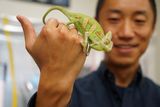Now Reading: Chameleon Tongues Inspire Breakthroughs in Medicine and Space Tech
-
01
Chameleon Tongues Inspire Breakthroughs in Medicine and Space Tech
Chameleon Tongues Inspire Breakthroughs in Medicine and Space Tech

Quick Summary
- Study Highlights: A new analysis in Current Biology explores the tongue mechanics of chameleons and salamanders, revealing both use a “slingshot” system for capturing prey.
- Findings: Despite differences in habitat, these species independently evolved similar tongue movements using ordinary tissues, tendons, and bones seen in other vertebrates.
- Potential Applications: The study suggests these mechanical systems could inspire innovations in biomedical tools (e.g., blood clot devices) and technologies for retrieving objects from hard-to-reach places on Earth or space.
- Notable Quotes: Researcher Yu Zeng called it surprising that such extraordinary performance is achieved with common anatomical components shared among vertebrates.
Images:
- Scientist Yu Zeng examines a reptile under a microscope at USF’s Deban Laboratory (Image Credit: USF).
- Reptile using its high-speed tongue to catch an insect (Image Credit: USF).
Indian Opinion Analysis
The discovery demonstrates how insights derived from natural evolution can address engineering challenges faced by humanity today-a concept highly relevant to India’s expanding focus on biotechnology and space exploration. With findings focusing on ordinary biological materials inspiring extraordinary functions, this could inform affordable tech solutions adaptable to diverse Indian infrastructures.
Moreover, the emerging potential applications for retrieving debris or clearing blood clots highlight avenues for enhancing disaster response mechanisms or improving medical care within resource-constrained environments like India’s rural regions.
India must orient itself toward leveraging bio-inspired tech discoveries via partnerships between academia and industries such as ISRO or health-tech firms-positioning itself at the forefront of innovation while addressing domestic challenges more sustainably.

























